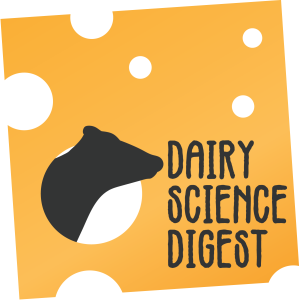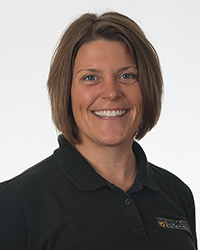Dairy Science Digest
Dairy Science Digest - a podcast developed to share the MOST current research published in the Journal of Dairy science. Hear directly from the research authors on how their results can impact your herd’s profitability. Science you can base your management decisions around. Designed to rarely exceed 30 minutes, this podcast provides ONLY the ”need to know” info for dairy producers. Keywords: dairy, science, reproduction, production, extension, cattle, MIZZOU, MU, Dairy Team, #2xAg2030
Episodes

Monday Aug 19, 2024
DSD 5.8 | Magnesium matters
Monday Aug 19, 2024
Monday Aug 19, 2024
Seems like calcium and phosphorus gather up all the attention, but there is growing awareness of the importance of magnesium – the “runner up mineral” in the dairy cow diet. Some sources of magnesium are simply more available than others. This fact has the ignited the interest of ruminant nutritionists looking to focus their research efforts on determining the most available Mg source so you can get the biggest bang for your buck.
This month we featured an article from Dr. Noelia Silva Del Rio, from UC Davis. She describes her research on the rumen availability of different popular magnesium sources and explains the importance of magnesium and how to improve the mineral status of your herd. Listen in to learn more!
Topics of discussion
1:32 Introduction of Dr. Noelia Silva 3:28 How does vitamin D impact mineral absorption? 3:42 Regulation of bone mineral mobilization 3:55 relationship of Mg normalizing blood vitamin D4:53 Human mineral deficiencies 6:21 5 forms of Mg researched: Most soluble, most common and a proprietary blend 7:57 Bolus vs pre-mix8:51 How magnesium is absorbed in the cow9:42 Solubility trial: popular is not the same as available 12:18 Why were open, non-lactating dairy cows tested? 13:11 Urine results over 24 hour15:22 MgS most available (Figure 2)16:27 Adjust for pre-treatment Mg excretion (Figure 3) 18:09 Recommendations for Nutritionists20:17 Quick field test for Mg availability 20:57 Take home message for boots on the ground dairy producers
Featured Article: Relative availability of 5 inorganic magnesium sources in non-pregnant, non-lactating Holstein cows.
Additional Information:Dr. Goff’s field test - https://www.dairyherd.com/news-news-news/magnesium-most-critical-mineralRecommended mineral paper for producers: https://avmajournals.avma.org/view/journals/javma/222/11/javma.2003.222.1518.xml
#2xAg2030; #journalofdairyscience; #openaccess; #MODAIRY; #Magnesium; #Mg; #Ca; #P; #mineral; #dairy; #hypocalcemia; #dairysciencedigest; #ReaganBluel;

Thursday Jul 18, 2024
DSD 5.7 |Machine learning to find SARA prevalence in your herd
Thursday Jul 18, 2024
Thursday Jul 18, 2024
Subacute Ruminal acidosis, commonly referred to as SARA, could be robbing your herd of production. When pH dips too low for too long the biology of the rumen shifts, butterfat slides and overall health of the herd is negatively impacted.
But how can you tell if your herd has SARA?
This month we invite Dr. Eric Paquet and Felix Huot, from Université Laval in Quebec Canada to explain the method of using DHI milk samples to map the prevalence of SARA in the dairy herd of Quebec.
Listen in to learn more -
Topics of discussion
1:48 Introduction of Dr. Eric Paquet and Felix Huot 2:55 What is SARA – how is it defined what are the symptoms? 4:42 Pair Feeding – Intake experimental design5:10 Rumen Bolus for research monitoring for calibration6:57 Rumen pH for definition of SARA7:40 7 commercial herds for phase 1 calibration 10:35 Ruminal Biochemistry changed by SARA13:08 Ruminal variability among cows within the same herd14:54 Phase 2: applied statistical model to a dataset of 3000 farms in Quebec to predict prevalence 17:24 Mean, range (min-max) prevalence of SARA18:35 Factors associated with an increase prevalence of SARA19:27 Robotic herds20:50 Seasonal effect 21:40 Higher milk yield 22:05 Take home message for boots on the ground dairy producers
Featured Article:
Featured Article: Predicting subacute ruminal acidosis from milk mid-infrared estimated fatty acids and machine learning on Canadian commercial dairy herds
Background Information:Relationship between farm management strategies, reticuloruminal pH variations, and risks of subacute ruminal acidosis
#2xAg2030; #journalofdairyscience; #openaccess; #MODAIRY; #SARA; #machinelearning; #VFA; #milk; #fattyacid; #acidosis; #FA; #dairysciencedigest; #ReaganBluel;

Saturday Jun 15, 2024
DSD 5.6 | Heat stress changes to the Mammary Gland
Saturday Jun 15, 2024
Saturday Jun 15, 2024
When your bulk tank volume takes a plunge through the last bout of heat, do you ever wonder exactly WHY? What is it in the udder that changes to cause the decline? Why do we also commonly see elevated SCC in our tanks too?
To best understand the why, the Virgina Tech dairy team collected tissue samples from the mammary gland of cows in controlled environmental chambers. This month we invite Dr. Ben Corl to explain the cellular changes observed in the alveoli, epithelial and even immune cells of the mammary gland of cows undergoing a controlled heat stress challenge.
Additionally, he’ll describe the changes in gene expression in those same tissue samples that controls protein production and mammary health.
This continuation of our heat stress series features two papers titled: (1) Cyclical heat stress during lactation influences the microstructure of the bovine mammary gland(2) 2022: Heat stress increases mammary epithelial cells and reduces viable immune cells in milk of dairy cows
Topics of discussion
1:28 Introduction of Dr. Ben Corl2:36 Describe the experimental design 3:58 Pair Feeding – Intake experimental design7:14 Could the cows cool during the evening ? 8:47 Microscopic changes to the mammary 10:31 Cellular turnover in the alveoli 13:20 Increased losses of epithelial cells, a portion of the somatic cell population 16:39 Decline in viable Immune cell population in the mammary 19:38 Body temperature before and after milking 20:16 Number of alveoli24:07 Gene & protein expression changes 24:56 Gene expression pathway for cellular health in the mammary26:25 What do you want Boots on the ground dairyman to know
Background Information:Temperature Humidity Index (THI)
#2xAg2030; #journalofdairyscience; #openaccess; #MODAIRY; #heatstress; #alveoli; #milk; #mammarydevelopment; #mammary; #dairysciencedigest; #ReaganBluel;

Wednesday May 15, 2024
DSD 5.5 | Avoid generations of production losses
Wednesday May 15, 2024
Wednesday May 15, 2024
Florida researchers began a generational study in 2007 that is still years in the making. It all began with the investigation of the impact of heat stress on dry cows to measure changes that might occur to the calf incubating inside the hot dam, like a crock pot.
In addition to seeing negative production impacts on mama, the researchers began to measure numerous changes in the damaged calf coming out of the heat stressed dry cow. This month’s edition, we’ll be interviewing Dr. Jimena Laporta, of the University of Wisconsin, to better understand the physiological changes of the calf that results in lost production for her entire life. She and her team measured changes in mammary and adrenal gland development.
Several separate papers have been peer reviewed over the 17 years of research. Many are linked at the bottom of the show notes for additional reference.
Listen in to understand how heat stressed dry cows can destroy your favorite cow families’ production records.
This month features two released paper titled: (1) Carry-over effects of maternal late-gestation heat stress on granddaughter’s growth and mammary gland development (ck out histology – Fig 1&2) (2) Programming effects of intrauterine hyperthermia on adrenal gland development
Topics of discussion
1:58 Introduction of Dr. Jimena Laporta4:17 Describe the experimental design 6:19 Description of the generations impacted through in utero heat stress 7:29 The biological link between the grand dam and the grand daughter (F2) 9:16 Eight years of research to collect multigenerational data 10:39 F1 management in WI beginning at 8 weeks12:00 F1 mammary implications following heat stress while developing in utero 13:32 F2 calves – changes as a result of dam’s exposure to heat stress while developing in utero15:01 Early mammary growth 15:32 What is causing these differences in F217:35 Lumen space and estrogen receptors 19:06 Summary of 3 generations of damage 20:34 Should I build a lactating barn or dry cow barn? 22:39 The Adrenal Gland 27:38 Adrenal effect on inflammation28:56 What do you want Boots on the ground dairyman to know
Background Information:Temperature Humidity Index (THI)2020 Dairy Science Digest Podcast interview 2020: Late-gestation heat stress impairs daughter and granddaughter lifetime performance (economic impact)2016: In utero heat stress decreases calf survival and performance through the first lactation
#2xAg2030; #journalofdairyscience; #openaccess; #MODAIRY; #heatstress; #fetalprogramming; #F1; #milk; #adrenal; #mammarydevelopment; #mammary; #dairysciencedigest; #ReaganBluel;

Friday Apr 19, 2024
DSD 5.4 | Reconsider Choline for lasting returns
Friday Apr 19, 2024
Friday Apr 19, 2024
Choline, a pseudovitamin, is required by all mammals including the dairy cow for many essential functions. Research in supplementing rumen protected choline really took off about twenty years ago, however continues today to best understand how this feed through additive can positively influence profitability. Dr. Usman Arshad joins the conversation for this episode to highlight his comprehensive summary of all the peer reviewed, published research completed on Choline. Listen in to best understand the assumed mode of action choline uses to help provide an improved efficiency in milk production for the majority of the lactation, even when only fed during the 42-day transition period.
The findings we discuss are published in the recently released paper titled: Exploring choline's important roles as a nutrient for transition dairy cows
Topics of discussion
1:19 Introduction of Dr. Usman Arshad2:17 What is Choline?3:45 Phospholipid production – choline’s role6:15 How does choline impacts the transition Cow7:46 Fatty acid impact on the Liver 8:39 Major factor choline plays on fatty acid transport 13:16 Twenty year average Milk Response when feeding choline for 42 days (-21 to 21 dim)15:47 Milk Response when feeding choline – more current average from 2020-202417:18 Mode of action, intestinal lining?20:02 Additional possible modes of action21:47 Choline as a treatment for fatty liver 23:24 Choline results in elevated milk yield, regardless of body condition score 26:16 Inflammation through in early lactation 27:29 Energy cost of bacterial infection30:30 What’s the one take home message for boots on the ground dairymen31:35 Return on investment calculations
Featured article: Exploring choline's important roles as a nutrient for transition dairy cows
#2xAg2030; #journalofdairyscience; #openaccess; #MODAIRY; #Choline; #transition; #transitiondairy; #vitamin; #fattyacid; #negativeenergybalance; #TMR; #dairysciencedigest; #ReaganBluel;

Friday Mar 15, 2024
DSD 5.3 | Slight modifications of CIDR Sync - help or hinder?
Friday Mar 15, 2024
Friday Mar 15, 2024
DSD 5.3 | Slight modifications of CIDR Sync - help or hinder?
In this time of heifer inventory shortage – getting heifers pregnant (in a timely fashion) is even more important than ever.
Contract heifer growers in California sought the help of Dr. Fabio Lima and his team at UC Davis to best understand the use of a 6-day CIDR sync with variable rates of GnRH could increase pregnancies when bred to sexed semen.
The findings we discuss are published in the recently released Journal of Dairy Science article titled: Effect of 200 μg of gonadorelin hydrochloride at the first GnRH of a CIDR Synch program on ovulation rate and pregnancies per AI in Holstein heifers.
Listen in to hear the results and nuanced details of controlling reproductive structures using timed AI protocols.
Topics of discussion
1:03 Production costs of heifer rearing - survey results 2:09 Introduction of Dr. Fabio Lima 3:46 Description of the project 4:20 TAI protocol description5:31 Varying GnRH dose6:34 What is the function of GnRH in the heifer? 7:51 Hallmark of a successful synchronization 8:24 Results of ultrasound (ovulation) and P4 blood sample analysis 10:04 Did increased ovulation translate into improved pregnancy outcome? 10:44 Pregnancy at d47, 100% sex semen discussion13:41 Relationship of Luteinizing hormone and progesterone 15:16 What causes elevated circulating progesterone 16:30 How did we land on 2cc of GnRH to begin with? 18:34 Does increased GnRH cause increased twinning? 21:02 What do you want boots on the ground dairymen to know23:01 What if you cherry picked? 23:32 Sometimes the plan doesn’t work – but that’s why we do research! Featured article: Effect of 200 μg of gonadorelin hydrochloride at the first GnRH of a CIDR Synch program on ovulation rate and pregnancies per AI in Holstein heifers
Articles also discussed in the podcast:Heifer study using 100 and 200 ug in 5-d CIDR Synch protocol. https://doi.org/10.1016/j.theriogenology.2023.04.026
Studies showing the implication of progesterone for double ovulation (a proxy for twining) and progesterone. https://doi.org/10.3168/jds.2018-14410
#2xAg2030; #journalofdairyscience; #openaccess; #MODAIRY; #gnrh; #CIDRsync; #twinning; #pregnancy; #heiferdevelopment; #TAI; #lutenizing; #dairysciencedigest; #ReaganBluel;

Thursday Feb 15, 2024
DSD 5.2 | Stop fresh cow subclinical mastitis in its tracks without withhold
Thursday Feb 15, 2024
Thursday Feb 15, 2024
Getting the fresh cow off to a strong start has ripple effects for her entire lactation. Subclinical mastitis rarely gets treated due to an unawareness or a lack of interest in pulling her from the tank. Nisin is a naturally occurring antimicrobial that’s been used widely as a food preservative. Dr. Zelmar Rodriguez and his team from Michigan State University looked at using this familiar antimicrobial to treat subclinical mastitis. The result, reduced clinical cases of mastitis.
Listen in to learn more about the return on investment of using Nisin on subclinical mastitis found in the first week of milk using CMT.
These findings are published in the recently released paper titled: Economic impact of treatment of subclinical mastitis in early lactation using intramammary nisin
Topics of discussion
1:20 Introduction of Dr. Zelmar Rodriguez 2:20 What is nisin 3:42 No dump milk4:10 Subclinical mastitis assessment 5:00 CMT discussion6:00 What day should we sample7:00 Subclinical mastitis prevention7:39 How does CMT work?8:46 Factors that impact effectiveness 9:18 What will nisin not work on – gram negative discussion12:36 ROI/cow13:23 Treatment regimen 13:42 Assessment to begin protocol15:36 Effect of employee training 17:16 Model at herd level – ROI19:33 FDA status20:22 Limitations of using DHIA hot sheet22:13 What do you want boots on the ground dairymen to knowFeatured article: Economic impact of treatment of subclinical mastitis in early lactation using intramammary nisin
#2xAg2030; #journalofdairyscience; #openaccess; #MODAIRY; #nisin; #earlylactation; #subclinical; #mastitis; #treatment; #dairysciencedigest; #ReaganBluel;

Monday Jan 15, 2024
DSD 5.1 | Energy saved is energy earned
Monday Jan 15, 2024
Monday Jan 15, 2024
Efficient production is the name of the game, and the key to an efficient cow is her rumen microbiome. The highlighted research this month focuses in on the intersection of Genome of the host cow, Microbiome within the rumen and the Intersection of the two.
To best understand the rumen efficiency story we talk this month with Dr. Guillermo Martinez Boggio from University of Wisconsin, about his recently released paper titled: Host and rumen microbiome contributions to feed efficiency traits in Holstein cows. Here they studied how the rumen and the host interact and if that interaction can become a selection trait in the future.
Much of the discussion today is focused around Carbon chasing. Just like “a penny saved is a penny earned,” whenever carbon is conserved by the rumen microorganism, energy is conserved. This carbon unit of energy can then be used to produce more milk when conserved. Listen in to learn more about the interconnected web between the cow and her microbiome.
Topics of discussion
1:52 Introduction of Dr. Guillermo Martinez Boggio3:15 Description of project 3:41 Dry matter intake vs Residual feed intake 5:09 Efficient use of Carbon 7:04 Saved energy yields more 8:25 Community of rumen organisms 10:29 What model best served to identify the most efficient digestion 11:35 Using microbiome as another source of information used genomic equation 12:02 Genome | Microbiome | Interaction of MicrobiomeXGenome12:17 The cow controls the rumen microbiome 12:51 Sire selection traits 14:08 How to obtain the most reliable breeding values 15:35 Using the rumen microorganisms for prediction and selection 16:45 Future research What do you want dairy producers to know from your research 17:21 Identify the “extreme” cows 18:12 Proxy traits
Featured article: Host and rumen microbiome contributions to feed efficiency traits in Holstein cows.
#2xAg2030; #journalofdairyscience; #openaccess; #MODAIRY; #microbiome; #methanereduction; #sustainabledairy; #rumen; #stillbirth; #dairysciencedigest; #ReaganBluel;

Friday Dec 15, 2023
DSD 4.12 | Mature mamas sail through transition with beef cross calves
Friday Dec 15, 2023
Friday Dec 15, 2023
Beef on dairy is here to stay. These cross animals generate a revenue stream for dairies as it lubricates the parallel industry of beef production. Much research is being poured into this topic to ensure producers can make wise breeding choices going forward. This month we talk with Bailey Basiel from Penn State University, about their recently released paper titled: The impact of beef sire breed on dystocia, still birth, gestation length, health, and lactation performance of cows that carry beef x dairy calves.
While we all know how desirable this cross calf is to the market, there’s very little knowledge about how these breedings impact the dam, until now. Listen in to how this research team sought to determine if there were any negative production implications to your dairy herd when you breed to beef.
Topics of discussion
1:27 Introduction of Bailey Basiel 2:26 Objectives of the trial – Impact carrying beef on dairy calf might have on the dairy cow3:24 Board invited review of Beef on Dairy 4:05 Historical background of Beef on Dairy5:15 Calf fed Holstein model 7:54 Data set description10:05 Beef semen description10:47 Gestation length13:00 Management changes based on gestation length 14:00 Wagyu crosses15:00 Long gestation, does that equal stillbirth?17:10 Health impacts for dams bred to beef semen20:35 Next research / records needed for genetic assessment - 23:23 What do you want dairy producers to know from your research Featured article: The impact of beef sire breed on dystocia, still birth, gestation length, health, and lactation performance of cows that carry beef x dairy calves.
Also mentioned in the discussion:
Translational Animal Science Article - Beef on Dairy ReviewDSD 1.5 | Beef on Dairy – sire conception rate, Taylor McWhorterDSD 4.6 | Accounting for Accelerated genetic improvement, Dr. Asha Miles
#2xAg2030; #journalofdairyscience; #openaccess; #MODAIRY; #beefondairy; #sexedsemen; #calffedmodel; #gestation; #stillbirth; #dairysciencedigest; #ReaganBluel;

Wednesday Nov 15, 2023
DSD 4.11 | Reproduction Revolution
Wednesday Nov 15, 2023
Wednesday Nov 15, 2023
Over the past 30 years the reproduction status of dairy has improved substantially, largely due to research around reproduction synchronization. This month we talk to Dr. Paul Fricke and Megan Lauber from the University of Wisconsin, about their recently released paper titled: Effect of postpartum body condition score change on the pregnancy outcomes of lactating Jersey cows inseminated at first service with sexed Jersey or conventional beef semen after a synchronized estrus versus a synchronized ovulation.
We discuss the how to maximize the equation of fertility, through management. Once optimized, you’ll find your herd entering the “high fertility cycle”. When all the stars align, production is high – disease is low and you are able to begin to stack reproductive technologies – such as genomically determined breedings using sexed and beef semen use following the ideal synchronization.
Listen in to learn how to get your herd there and the physiology behind it.
Topics of discussion
1:54 Introduction of Dr. Paul Fricke & Megan Lauber 4:23 Objectives of the trial – stacking reproductive strategies 3:34 On farm monitoring – data collected 6:10 Getting all the cows on day 7 – the key to unlocking fertility7:44 The history of Luteolysis – why is it so critical?9:57 Rate limiting step of pregnancy 12:03 2019-2021 xx and beef semen usage 13:54 Research protocols and design 16:20 Equation of reproduction; comparing double ovsync vs estrus 17:50 Estrus or Double ovsync for Sexed semen 16:14 Day 19 – 40 pregnancy loss 17:30 What’s happening when the GnRH shot is given? 22:13 The impact of Body Condition Score (BCS) change on fertility | >0.5 24:53 High fertility cycle 25:52 Not all cows loose condition through transition, those that did were impacted26:38 Results: Double ovsync helps mitigate poor transition (Figure 4)29:09 Why does it work? What physiology controls it? 30:15 Fat regulates GnRH?!32:30 What do you want dairy producers to know from your research Featured article: Effect of postpartum body condition score c hange on the pregnancy outcomes of lactating Jersey cows inseminated at first service with sexed Jersey or conventional beef semen after a synchronized estrus versus a synchronized ovulation.Also mentioned in the discussion: Characterization of semen type prevalence and allocation in Holstein and Jersey females in the United States
#2xAg2030; #journalofdairyscience; #openaccess; #MODAIRY; #reproductionrevolution; #highfertilitycycle; #Ovsync; #DoubleOvSync; #transition; #transitiondairy; #dairysciencedigest; #ReaganBluel

Reagan Bluel
As dairy specialist at the University of Missouri, I am passionate about providing research based information to dairy producers in a format easy to listen to.
Log in every month to learn straight from the researchers, information that could transform your herd.
For more information reach out at reagan@modairy.org or bluelrj@missouri.edu










